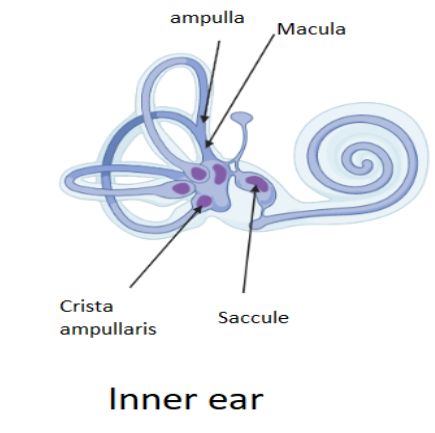Answer
415.8k+ views
Hint: The membranous labyrinth of the inner ear is filled with a fluid called endolymph. Potassium is the major cation present in the endolymph along with sodium. a membranous labyrinth refers to the inner portion of the ear that consists of fluid-filled tubes and chambers.
Complete answer: Human ear consists of three parts called external ear or pinna, middle ear, and inner ear. The inner ear is made up of two parts: the membranous labyrinth and the bony labyrinth. The membranous labyrinth of the inner ear is filled with a fluid called endolymph. A fluid called perilymph is present in the space between the wall of the bony labyrinth and the outer wall of the membranous labyrinth. Endolymph contains white crystals of CaCO$_3$ called otoconia or otoliths. Otolith is a structure made up of calcium carbonate present in the saccule of the utricle of the inner ear. The utricle and saccule together make the otolith organ. Otoliths are tiny particles that are made up of calcium carbonate and gelatinous matrix in the viscous fluid endolymph of the utricle and saccule. The hair cells are stimulated by the inertia of these small particles when the head moves. Otoliths are used as movement, balance, gravity, and directional indicators in all vertebrates. The secondary function of otoliths is to detect the sound in higher aquatic and terrestrial vertebrates.

So, option D is the correct option.
Note: An otolith is also known as otoconium or statconium or statolith. This organ is responsible to perceive the linear acceleration, both vertically and horizontally in all organisms including humans. In invertebrates, the same analogous structure called statocysts is found to perceive the linear acceleration.
Complete answer: Human ear consists of three parts called external ear or pinna, middle ear, and inner ear. The inner ear is made up of two parts: the membranous labyrinth and the bony labyrinth. The membranous labyrinth of the inner ear is filled with a fluid called endolymph. A fluid called perilymph is present in the space between the wall of the bony labyrinth and the outer wall of the membranous labyrinth. Endolymph contains white crystals of CaCO$_3$ called otoconia or otoliths. Otolith is a structure made up of calcium carbonate present in the saccule of the utricle of the inner ear. The utricle and saccule together make the otolith organ. Otoliths are tiny particles that are made up of calcium carbonate and gelatinous matrix in the viscous fluid endolymph of the utricle and saccule. The hair cells are stimulated by the inertia of these small particles when the head moves. Otoliths are used as movement, balance, gravity, and directional indicators in all vertebrates. The secondary function of otoliths is to detect the sound in higher aquatic and terrestrial vertebrates.

So, option D is the correct option.
Note: An otolith is also known as otoconium or statconium or statolith. This organ is responsible to perceive the linear acceleration, both vertically and horizontally in all organisms including humans. In invertebrates, the same analogous structure called statocysts is found to perceive the linear acceleration.
Recently Updated Pages
Mark and label the given geoinformation on the outline class 11 social science CBSE

When people say No pun intended what does that mea class 8 english CBSE

Name the states which share their boundary with Indias class 9 social science CBSE

Give an account of the Northern Plains of India class 9 social science CBSE

Change the following sentences into negative and interrogative class 10 english CBSE

Advantages and disadvantages of science

Trending doubts
Fill the blanks with the suitable prepositions 1 The class 9 english CBSE

Which are the Top 10 Largest Countries of the World?

Difference between Prokaryotic cell and Eukaryotic class 11 biology CBSE

Differentiate between homogeneous and heterogeneous class 12 chemistry CBSE

10 examples of evaporation in daily life with explanations

One cusec is equal to how many liters class 8 maths CBSE

Give 10 examples for herbs , shrubs , climbers , creepers

Difference Between Plant Cell and Animal Cell

How do you graph the function fx 4x class 9 maths CBSE



